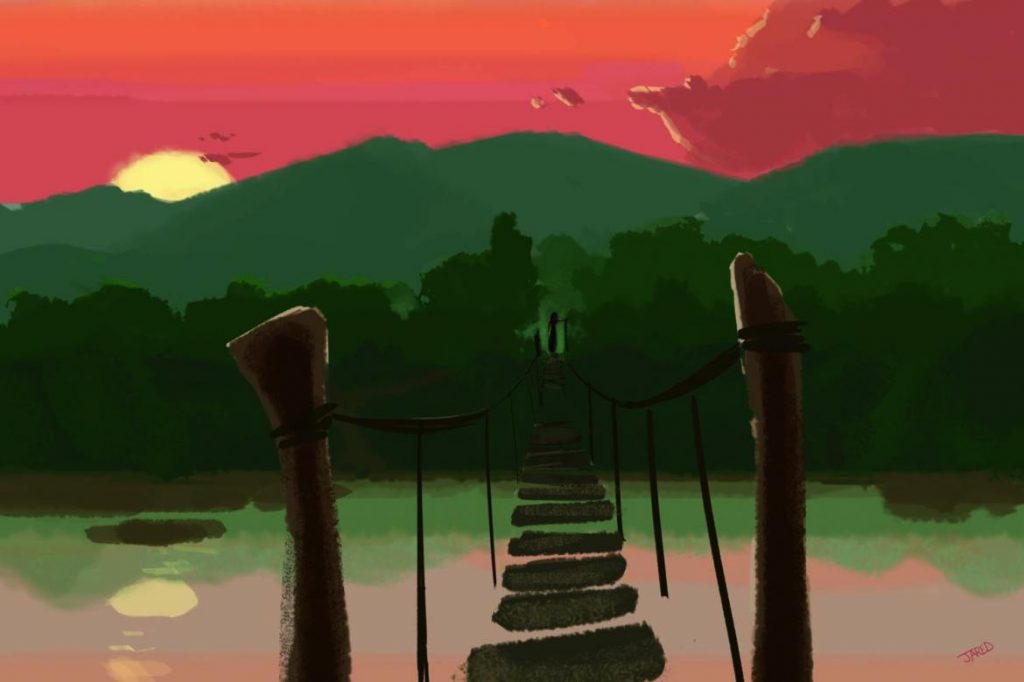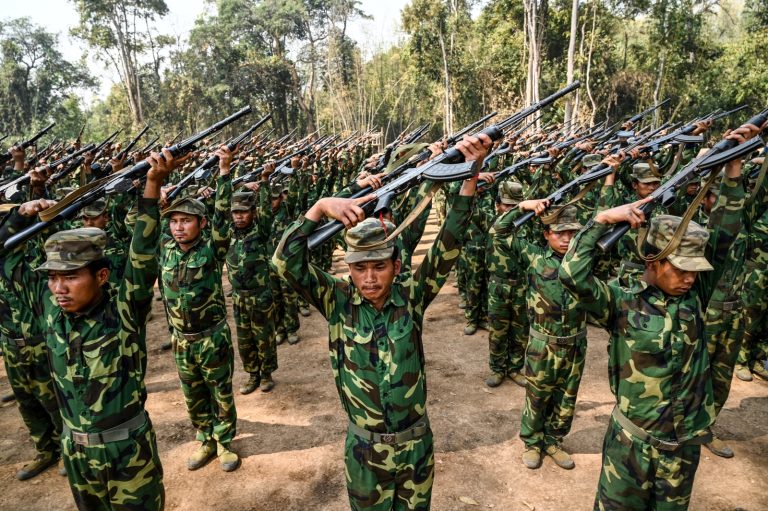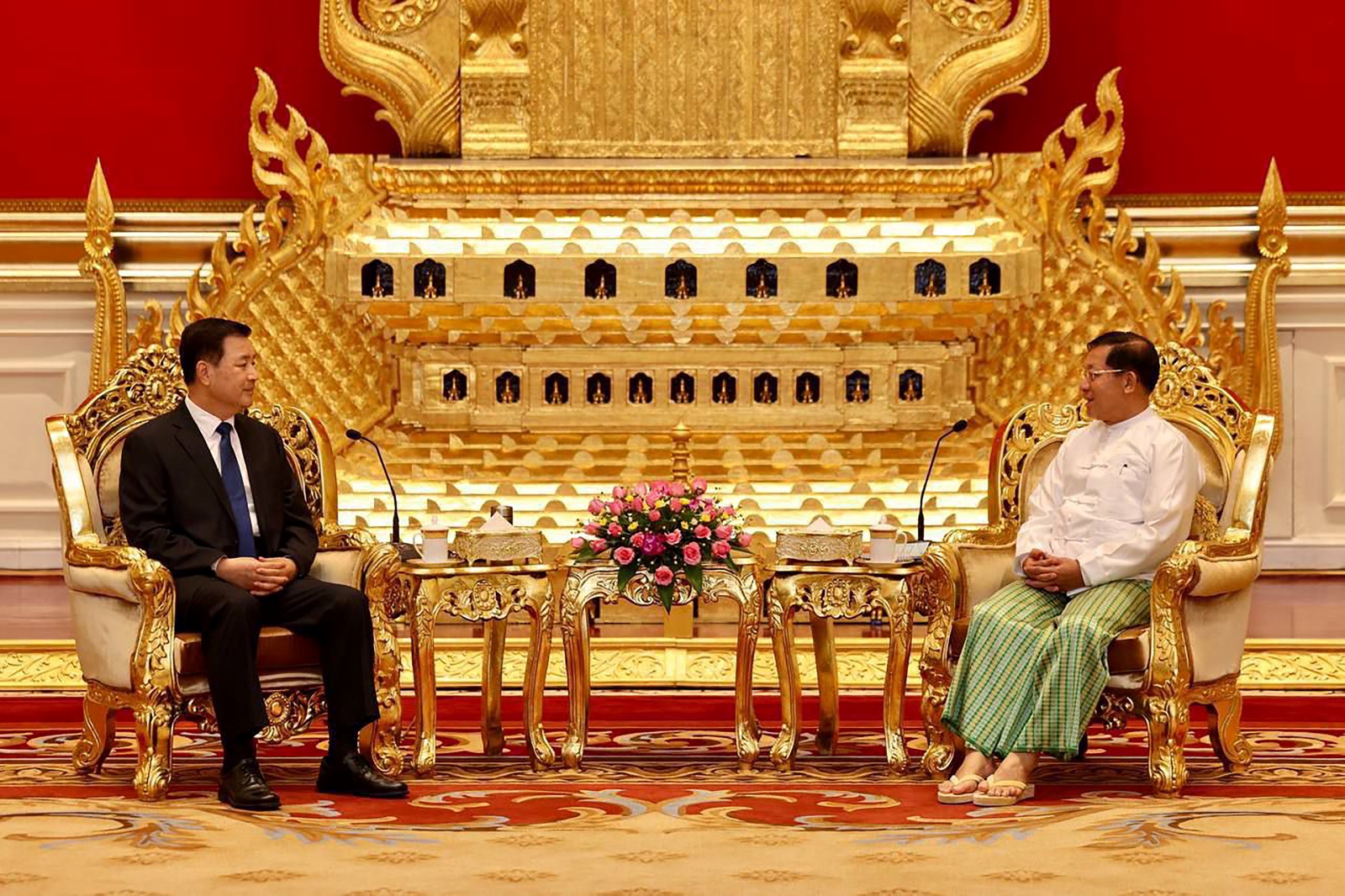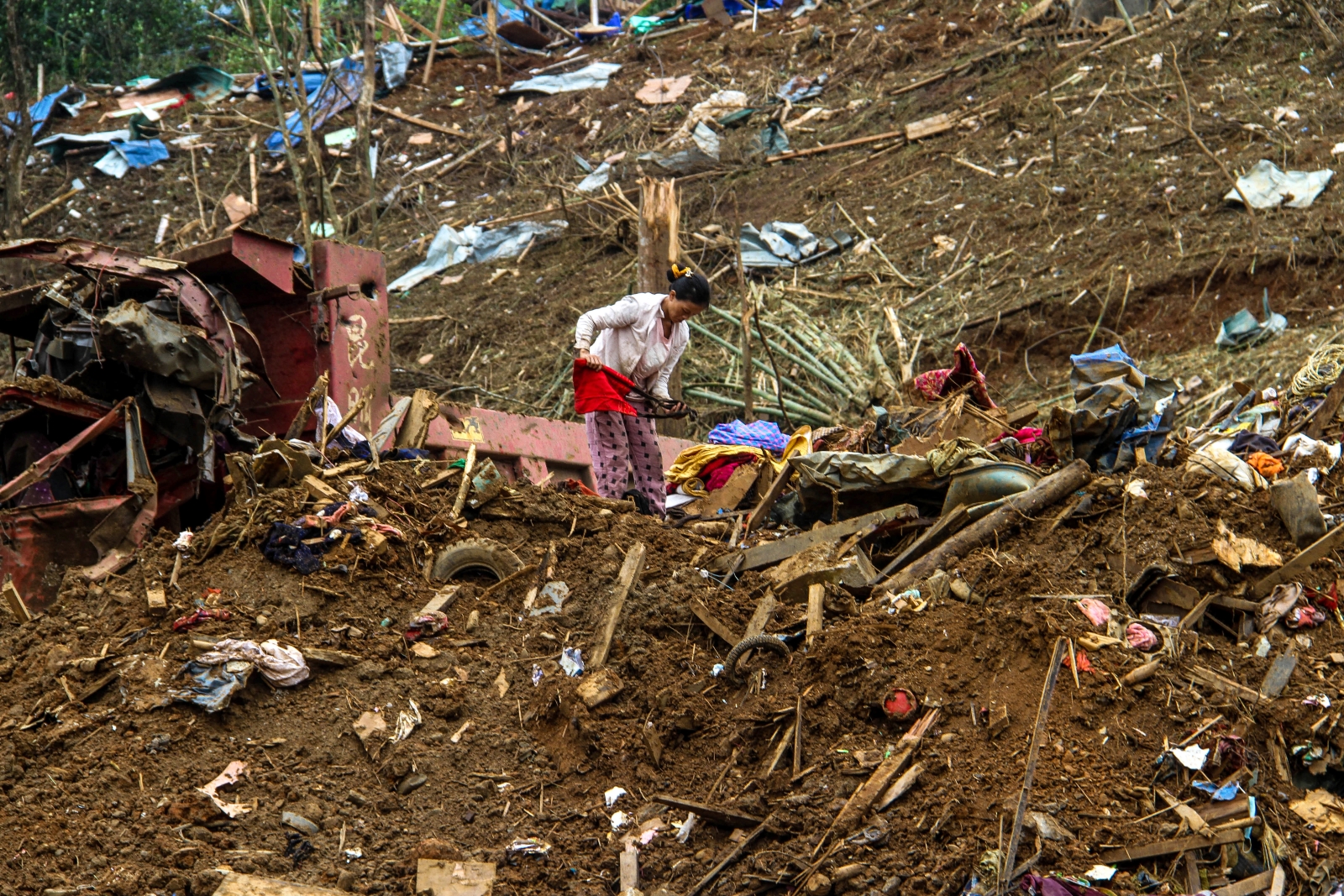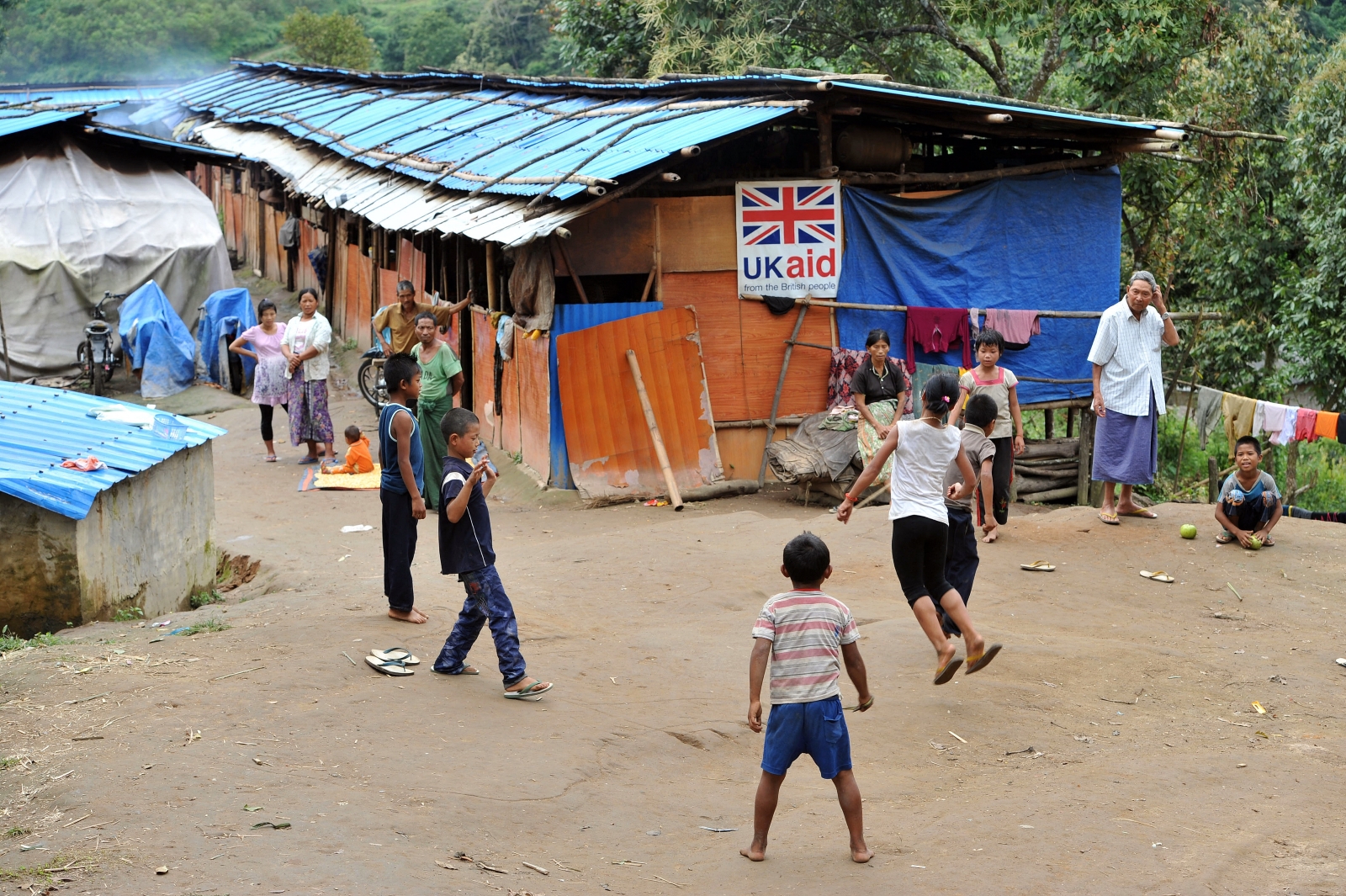A semi-autobiographical work of fiction set in the jade mining town of Hpakant in Kachin State, where landscapes are ravaged and people discarded like the rocks they scramble for.
By MALIHKU SHINGNI | FRONTIER
The fog comes early in the morning. A person or two passes me on the otherwise empty street. As I exhale, an early winter breeze carries my breath like smoke to unclear places in the distance. I shiver. I feel so cold without my thick coat. I walk to a small bank under a bridge suspended in rope, and stare at the thin water in Uru creek, stained with sweetened-tea coloured mud.
“Where has your beauty gone?” I wonder out loud, for I had heard from Kachin songs from old days of how beautiful the land here was, with wild birds flying in green hills and valleys and fish swimming in crystal clear water. Now, I can’t find any of these things, the land I see has changed. Has it been destroyed by mankind, or sacrificed for us? Or is it our fault, our Kachin people for not being able to protect our lands? I can’t find the answer, but I do know that once our ancestors guarded the Uru region well and now it has fallen into different hands, the hands of companies and corporations.
I walk up to the bridge and stand at its centre. Looking at the barren, collapsed hills around me, I ask the Uru Creek below another question, “is there a difference between those hills and my life?” But it doesn’t answer me. So I ask the bridge instead, “do you recall a story that started from here, from this very place?” It too has no reply but as the current of the Uru creek takes its muddy waters onwards I grip the handrail of the bridge and my mind stumbles to the past.
*
Ten years ago I went to Hpakant in west Kachin State. Most people come to this town dreaming of being a law pan, a big boss, but I was there for another reason, to teach kahprek. Most Kachin people know of Master Lazing La Htoi, who invented this martial art as a way for the Kachin to defend themselves. I taught it in the hope it would free my people from the slavery of drugs. I held my courses mornings and evenings on the ground floor of a Baptist church in Ngapyawtaw. It was called the Jade Church because several of its brick walls were decorated with Hpakant’s famous deep green jade cuttings.
Support more independent journalism like this. Sign up to be a Frontier member.
Life in Hpakant wasn’t easy at first and I became ill. I went to the pharmacy and bought three doses of four different medicines, which cost me three thousand kyats. I still had five thousand kyats in hand, so I spent another nine hundred on three rehydration salt packets. It helped me to feel better, but it wasn’t the welcome I was looking for in Hpakant. In time, however, I became friendly with one of my trainees. Robert was a short boy, brown skin, a little fat, always laughing, always talking. Whenever he was with his friends, he’d proudly introduce me to them. “This is my kahprek trainer, Master Zaw Htoi from Myitkyina.”
One day, I went to the local KBZ bank with Robert and, thanks to him, I was introduced to one of the bank-tellers, Ah Nang. I’m not the kind of man to fall for a girl just because of her beauty, but I did notice that she was a girl who didn’t wear thanaka well. On the way back from the bank, Robert was chattering, “If you look carefully, you’ll see she’s actually quite beautiful. She’s my friend, I know her well. She’s educated, good at cooking and housekeeping and everything.” The second time I saw Ah Nang was at the Jade Church, when she read a passage from the Bible during a Hpakant Regional Christian Youth meeting. While reading on stage, she looked frequently at me, so I smiled and she smiled back.
I began to see her more often after that. Twice a day, in fact, every morning and evening, from opposite sides of the same busy street we both walked. She on her way to the bank in the morning, me on my way back from training. She on the way back from the bank in the evening, me on my way to training. Despite the thirty feet of road between us, we started to build a bridge of our own. It was small at first, just smiles and glances, but over time, the bridge drew us closer and I could hear her whisper, “Are you going back?” and I’d reply, “Yes, take care.” My pupils, Robert and Pan Aung began to notice the bridge and even mocked it, saying, “Around here, you got to walk quickly.” I didn’t mind.
*
Most afternoons, I was free, so one day I decided to go and look for yemase, the unwashed stones. It was only after I came to Hpakant I learned about the unwashed raw, low quality jade thrown away by the big companies. Pan Aung lived near my place so he offered to come with me, “You’re not far from Hmaw Maung La Yan, I pick yemase over there, too.”
I slipped on a pair of long socks, doubled over to protect my feet, and a pair of strong shoes, then stuffed a raincoat and diamond hammer in my backpack. Pan Aung smiled at me and said, “Master, now you look like a real prospector.”
“Oh yeah? Hope that means I find a good piece of jade,” I wished.
He looked me up and down one last time and asked, “Did you pack water, Master? You should take something to eat as well.”
On the way, Pan Aung told me about the old days, when prospectors would use iron poles, picks and shovels to extract the stones. By now, however, Hmaw Maung La Yan had been taken over by companies who fenced off their own hills and whose compounds had iron roofs, employee hostels, fuel tanks and machines. Huge machines. A big company might own up to forty bulldozers and sixty trucks to haul away soil. “They can clear a whole mountain in less than six months,” said Pan Aung, slicing his hand along the horizon, cutting it away. Hundreds of these companies work in Hpakant and when they finish with the earth they dig up, they just dump it. “That’s where we look,” Pan Aung continued. “If you find a good piece of jade in those tailing piles, you need to sneak away quietly. If people from the company find out, they’d want it back.”
Now that I saw it with my own eyes, I felt miserable. Watching the locals claw their way through the dumped soil, it was no better than when the farmers in my village feed rice to their chickens. Hens, roosters and chicks of all different shapes and sizes rush in, screech and fight. Us Kachins are like animals caged up by foreign companies. I myself turned chicken that day, scratching the ground to find something, anything.
*

Freelance miners dig for raw jade stones in piles of waste rubble dumped by mechanical diggers next to a jade mine in Hpakant in October 2015. (AFP)
The sun was hot. Sitting on the tailing pile, taking a rest, drinking water and gazing from afar at our fellow prospectors, Pan Aung flicked a stone away and said, “You know, some companies don’t even let us pick the unwashed stones. They guard them with men and guns. And you know something else? They grade the companies here depending on the number of machines they use. The largest is A, then B and the smallest C.”
“And how many of those are owned by Kachins?” I asked.
“Some, but less than you can count on ten fingers all told. Plus, they’re all are only C grade, the smallest.” Pan Aung thought for a second, then added, “Well, maybe U Ywup Zaw Khaung’s company is B grade. Probably used to be A, but well, others steal our people’s land, so . . .” Pan Aung’s voice trailed off.
Spending the whole day at the hmaw was tiring, but I was lucky that day. I didn’t find a stone worth thousands, but I did find something worth much more: Ah Nang on the little suspension bridge connecting Hpakant to Mashi Ka Htaung. We often met here to talk, leaning over the handrail together to greet the sunset. As the weeks passed, I wanted to tell her how I felt, but I held back the words, wary of what she might say, afraid I’d ruin what we already had. But that wasn’t enough for me. I didn’t plan it, or think it through, but eventually one evening, as we stood together on the bridge, I held her hand and told her. She blushed and lowered her head to her chest. I waited, sick, for what she would say in return. After a long while, she sighed, “I knew you’d say this one day,” but then added, “It’s impossible, Zaw Htoi.”
“Why? Can you tell me?” I asked. My voice trembled. I felt helpless. She didn’t answer.
“Please, let me know, why?” I pleaded.
She looked away, then back at me, as if she wanted to say something but thought better of it. “No, it’s nothing,” she said finally.
*
I didn’t see Ah Nang for a while after that night. I spent my days alone, depressed, until a pupil of mine, Zaw San, asked if I wanted to pick stones at Hmaw Lon Khin. I needed the distraction, so we set out that very day on a Chinese 125cc motorbike. After only a few miles, Zaw San slowed down.
“Are we there already?” I asked, leaning on Zaw San.
“No, Master, but I wanted to show you something. Look down there.”
He pointed towards a row of bushes by the side of the road below. A steady stream of Chinese motorbikes rode in and out kicking up clouds of dust. Old men and young boys squatted alone as if they were peeing, others sat face to face as if in deep conversation. Still others queued in a crooked line toward a hut roofed with a blue tarp.
“That’s where they sell opium, Master,” said Zaw San, answering my unasked question.
I was shocked. “What? Really!”
“Over there, that blue hut, that’s where they sell it.”
I peered at the small opium market, all I could say was, “What a terrible place!”
Zaw San replied, knowing the scene was common in Hpakant. “Well, all the jade mines are like this.” Maybe for Zaw San and others who lived here it meant nothing, but I couldn’t shake the image of my people queuing up for heroin for nearly a week.
*
Staying in Hpakant, I came to know its stories well. I hadn’t known anything about jade before. I thought all dark lava-coloured stones were jade, although I’d heard that jade is heavier than normal stones. I then learned that when a stone looks like jade and feels heavy, you should crack it open with a diamond-headed hammer. Prospectors more knowledgeable than I would come to offer their insights. They told me once you split the stone, you should spit on it and wipe off the dirt to see its quality. Others would take the piece from my hand and lick it, even after I spat on it, just to make sure. They taught me about the different grades of jade, their quality, purity and colour. They showed me how to avoid being crushed to death when a truck poured unwanted soil down the hillside. Dirt, rocks and stones would tumble down to the waiting ants who’d would scramble for first pickings, often dislodging a boulder that would roll crashing down onto the slower ants below. If you`re an ant at the top, you need to call out “stone!” as loud as you can. If not, the other ants would curse you and sometimes beat you. The word has saved many lives in Hpakant. This is what it means to be Kachin and dream of a different tomorrow; a jade bridge crossing over from poverty to a life without it. I too became a yemase picker. We all found lots of stones, but almost none of them were jade.
*
It had been a long time since I’d seen Ah Nang. We never met across the road in the mornings and evenings like before. I guess she walked a different way to and from work. Just before I left Hpakant to return to my studies in Myitkyina, I bumped into Htoi Seng, a friend of Ah Nang, and immediately asked him about her.
“She does like you,” he said, “you should know that, but she isn’t sure about you yet. She worries what people will think if she is seen with you, especially now, with all the rumours of her father.” He paused. “This is a secret, okay? If Ah Nang knew I was telling you this, she’d be very angry with me. Her father is a Baptist preacher. Apparently, he left the family for another woman, so everyone’s watching them a little too closely right now.”
*
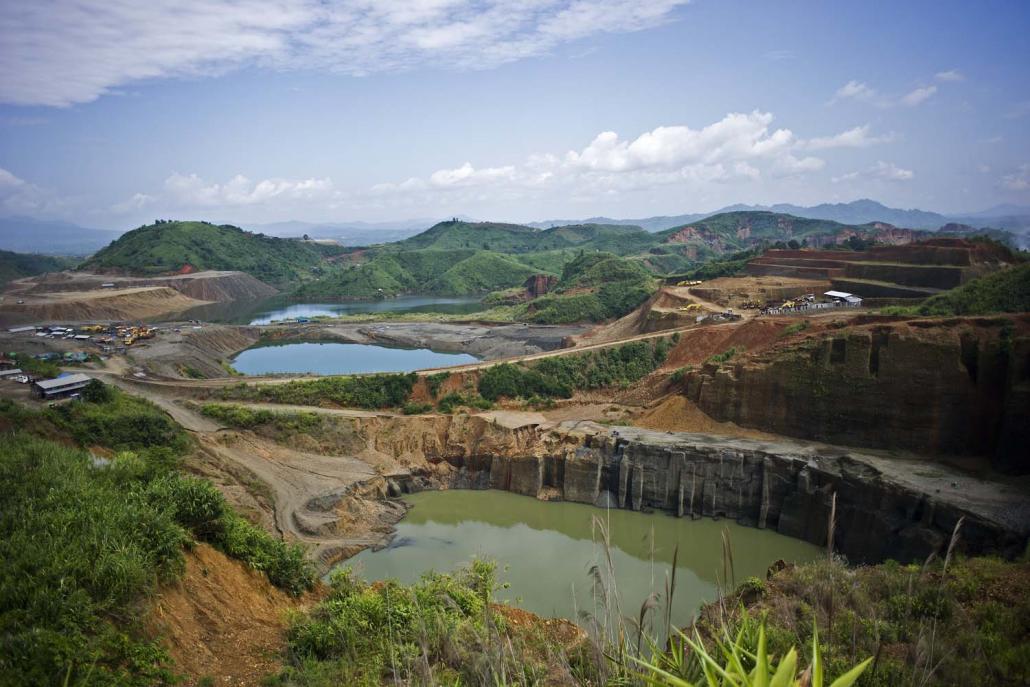
The once-beautiful hills of Hpakant, ravaged by jade mining, seen in October 2015. (AFP)
I completed another year of my degree studies at Myitkyina University and came back to Hpakant as soon as I could. I asked Htoi Seng to inform Ah Nang of my return, as I wanted to believe she still might feel something for me, but Ah Nang never visited me at the Jade Church. A friend, a girl from my home town came to visit, and Ah Nang saw us walking together. I smiled at Ah Nang, from across our usual street, but her face was clouded in doubt. I couldn’t blame her. When I saw her a week later with another boy, my face too darkened. Many friends knew about my feelings for her. One of them named Zaw Hseng attended her church. One evening, we went to Seit Nyein teahouse, and he asked me, “What do you really know about her?”
I didn’t know what to say.
“I want to tell you, as a friend, you should forget her,” Zaw Hseng continued.
“Why?”
He took another sip of his tea and considered what to say. “When she was young, she contracted malaria. It changed her, made her a little crazy. I guess she’s better now, but . . .”
Why should I write off a girl just because of that? “Let’s go,” I said, draining my cup.
Slowly, I rekindled my friendship with Ah Nang. We began to smile at each other from across the street, re-tying the threads that had snapped. On the rope bridge across Uru Creek, I held her hand once more and promised to love her, but all she’d say was, “No, Sra Zaw Htoi, it’s impossible between you and me.”
At midnight on the verandah of my hostel, I played guitar and sang the Kachin ballad “My love, my heart tells me it can’t live without you” to the light of her little house that was always on in the valley opposite. Weeks passed, and soon I had to return to Myitkyina for my final exams. Ah Nang looked at me for a while, then asked “When will you be back?”
I’d made up my mind never to return, but instead I lied, “I don’t know yet!”
I caught a Hi-Lux pickup out of Hpakant along a road that crisscrossed the high mountain ridges. A single lane so narrow that cars could only go one way, and should one of these cars break down, you’d be stuck there for days. In summer, dust from the lorries made it difficult to breathe, and in rainy season, elephants had to pull cars stuck in the mud. This was the main road from the jade mines to Myitkyina, the capital of Kachin State, where I sat for my exams.
After my exams, some friends and I were asked to help with security for that year’s Manau Festival. The field on the bank of the Ayeyarwady River was mown and swept clean. The wealthy Yup Zaw Khawn and Festival Committee members in their traditional Lai longyi, Lai turbans and black jackets walked around the shops, pandals and thatch-roofed committee huts. Little by little, the Manau field swelled with thousands of people from all the different Kachin groups in silver gong decorated costumes, silver swords and colourful turbans. The pastor finished the opening prayers and then came the naung shaung, the Manau dance leading troupe, wearing turbans made from bird feathers, peacock tails and wild boar’s horn. Behind the naung shaungs came the important leaders of the noble tribes, then the men and women from their villages. The first, sweet notes of the traditional flute came, followed by the deeper tones of the buffalo horn with the rumbling of drums and crash of the cymbals. “Tong… tong…tong…aay… Oh Lord in the highest of heaven . . . Oh the creator of all mankind… aay … aww lay lay.. woo.. tong.. tong.. tong..!” Whenever we hear that song, that rhythmic call of the Manau, every Kachin heart shivers as the blood of our ancestors before us flows again.
In the old days, only noble duwas could celebrate the Manau dance. Behind their long house, they’d clear a field and erect wooden Manau posts, where royal relatives and villagers would sit and drink and eat and dance and tell stories for nine days. The guests would bring presents, such as a buffalo, a much prized animal, gifts which would have to be reciprocated when they, in turn, held their own Manau. This is why only the duwas used to hold a Manau; they were the only ones who owned the land and slaves to afford it. Things are different now. The duwas have gone, or at least their powers have, and under the belief of Christianity, the Manau festival is organized by a committee of elders and sponsored by rich men.
*
After the Manau festival I returned one last time to Hpakant. I didn’t try to contact Ah Nang. It was clear to me that our story would not end well. Even after Htoi Seng told me Ah Nang did nothing but talk about me and wanted to meet me, I distanced myself from her. I did my last training sessions at the Jade Church, and left Hpakant and Ah Nang behind.
*
It was two years since I left Hpakant and let myself forget Ah Nang. Sometimes, I’d meet boys from that frontier jade town and be reminded of her. I might mention her name, hoping perhaps they knew her, but soon I stopped doing even that.
I met Htoi Hseng again, and he passed me Ah Nang’s number, saying, “She’s waiting for you to come ask for her hand.” I was curious, I admit, to hear her voice, to hear if she would say those words and if she was indeed waiting for me. So I tried to call her that evening, and every evening for the next four days, but the line just didn’t connect. And once again, I soon forgot about her.
Then, one day, while I was playing billiards Zaw Hseng came up to me.
“How are you, Master? It’s been a long time.”
“I’m fine, Zaw Hseng. How about you? What do you do now? Are you still picking jade stones?”
“Well, that’s all we can do in Hpakant!”
“Did you find any big stones?”
We chatted for a while before he asked me, “Did you hear about Ah Nang?”
“No, why?”
“She died.”
He spoke so bluntly, I was sure he was joking.
“No, I’m not. Why would I joke about something like this?”
I stared at him blankly for I don’t know how long. I was shocked, I didn’t know what to say.
“How?” I breathed as my heart began to weep.
“She died of heart disease. She fainted in Hpakant, so we brought her to Myitkyina. Her body is in the local mortuary.”
I went to her funeral at Jaw Bum cemetery, laid a rose on her casket, then helped cover it with soil. Htoi Hseng was with me, almost in tears.
“Here, this is Ah Nang’s diary. I’m sorry, I read it. She wrote how much she wanted to be with you.”
I knew then I had been wrong: I should have seen her that one last time in Hpakant, I should have tried harder to call.
“Everything is my fault. I’m sorry, Ah Nang.” With these words, I said my farewell.
*
You little bridge of Uru Creek, you are still here, though the thread between Ah Nang and myself has been cut, and like the disappearing mountains of the Uru Region and time itself, never to return.
This story appeared in the anthology Hidden Words, Hidden Worlds: Contemporary Short Stories from Myanmar published by the British Council in 2017 and has been reproduced with the kind permission of the author, who also translated it from Jinghpaw to Burmese, and Khin Hnit Thit Oo, who translated it from Burmese to English. Author Malihku Shingni (b.1988) trains youth in the Kachin martial art of kahprek at his gym in Myitkyina and writes articles on health and sports in Jinghpaw for the Kachin Times journal.


